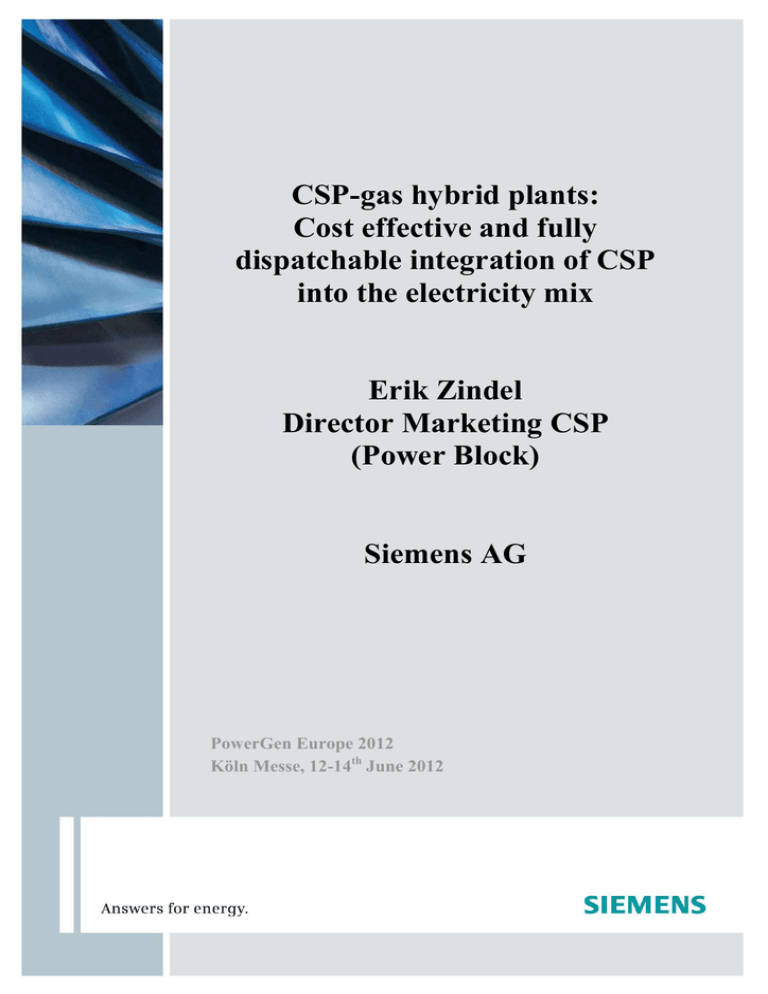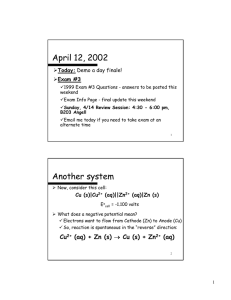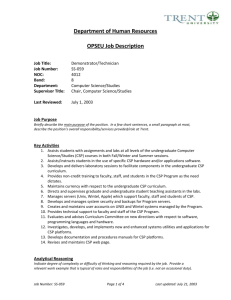
CSP-gas hybrid plants:
Cost effective and fully
dispatchable integration of CSP
into the electricity mix
Erik Zindel
Director Marketing CSP
(Power Block)
Siemens AG
PowerGen Europe 2012
Köln Messe, 12-14th June 2012
0. Abstract:
Today, Concentrated Solar Power (CSP) Plants are being implemented in several
countries around the world where corresponding incentive schemes for renewable
energies are in place. While some CSP technologies like parabolic trough can already
be considered proven and bankable, large scale introduction of CSP technology into the
electricity generation mix is yet limited mainly due to the relatively high costs of
electricity.
CSP Hybrid solutions can help bridging the gap from a mainly fossil to a fully renewable
power generation scenario. Although today’s incentive schemes do mostly disregard the
value of dispatchability and limit the share of allowable fossil fuel co-firing for CSP
plants, technology providers and developers are already working to advance technology
and project configurations to help improve project economics and thus the speed of
penetration of CSP into the electricity market.
Solar-gas hybrid power plants and integrated solar combined cycle power plants (ISCC)
are among the best configuration choices that can enable a much quicker fielding of
solar energy into today´s energy mix, as they represent a good combination of the
advantages of both combined cycles and CSP plants. Hybrid and ISCC plants offer the
following advantages:
- reduced costs compared with separate combined cycle and CSP plants
- higher efficiencies achieved for the solar part
- full operational flexibility and grid dispatchability
As such, hybrid power plants are a better solution compared to stand alone builds of
independent combined cycle and CSP power plants.
1. Introduction to CSP Hybrid Power Plants
In general, the word “Hybrid Power Plant” can refer to any plant configuration that is
based on more than one fuel or technology. As such, any Concentrated Solar Power
plant (CSP) that uses an additional fuel (e.g. gas, coal, biomass, etc.) can be called a
“Hybrid Power Plant”. For the sake of simplicity, this paper is only based on CSP/gas
hybrid plants, using parabolic trough technology. Other combinations of CSP with coal,
oil or biomass are also possible, as are the use of other CSP technologies like Parabolic
Trough with molten salt, Tower and Linear Fresnel technologies. The conclusions
shown in this paper apply for these combinations as well.
Concentrated Solar Power (CSP) Plants are being built in many countries with an ever
increasing development status since the first large projects were built in the 1980´s in
the USA. Concentrated Solar Power Plants use the direct irradiation of the sun by
means of concentrating them by the use of mirrors which is used to heat up a thermal
medium which itself is being used to generate electricity by means of a
thermodynamical cycle. It is the only renewable energy technology (apart from hydro
Siemens AG Energy Sector
E F ES CSP MKRW/EZ
Copyright © Siemens AG 2012. All rights reserved.
2
and biomass) that can offer a reasonable amount of dispatchability by means of molten
salt storage systems. The facts that CSP is still a rather new and innovative technology,
coupled with high costs (compared with conventional fossil fuelled power plants) have
so far limited its application potential.
In order to increase the share of renewable and solar energy into the electricity mix,
intelligent solutions are required that offer more cost effective solutions while fulfilling
the requirements for operational flexibility and dispatchability required by the grid
without having to resort to back up solutions. Hybrid CSP/gas solar power plants are the
ideal solution for this problem.
The rationale for CSP/gas hybrid power plants is that these plants offer the lowest costs
of solar electricity at an unprecedented level of operational flexibility and dispatchability
and are therefore a better solution compared with separate installations of Combined
Cycle Power Plants (CCPP) and CSP or PV plants. This is mainly because:
Synergies in plant design allow for much lower costs of contruction compared
with separate plants (one bottoming steam cycle vs. two, synergies in Balance of
Plant equipment)
The use of a larger steam cycle at higher steam conditions increases the
efficiency of the solar fraction compared with a stand alone CSP plant
High flexibility and dispatchability offered by hybrid plants enable full grid code
compliance even if no storage solutions are adopted. They also allow for a
flexible dispatching approach depending on the prevailing market conditions for
gas and electricity, thus increasing flexibility for the operator to adapt operation in
changing market environments.
2. Types of CSP/gas Hybrid Power Plants
CSP/gas hybrid plants can be catalogized into three different groups depending on their
solar/gas fraction, each allowing a multitude of different detail configurations, depending
on the equipment and thermodynamic design chosen:
Large Integrated Solar Combined Cycle Plants (ISCC): These projects can be
described as a conventional combined cycle plants that have a rather small CSP
field attached to. The ratio solar/gas is usually less than 20/80% (measured by
capacity). A typical configuration is e.g. an ISCC based on one SGT5-4000F gas
turbine with 450MW total power output for a low DNI site at local ambient
conditions, of which 51MW would be the contribution from the Solar Field. While
the pure CC gas efficiency would amount to 58.7%, total plant efficiency would
increase to 66.1%, if the additional solar energy is factored in. Main rationales
behind this configuration are:
- dispatch profile and costs like a conventional CCPP plant
- possibility to sell solar electricity at premium peak load prices
- resell some gas on spot market not required to meet full load at midday
- compensation of CCPP output drop at high ambient temperatures
- easy inroads into CSP technology for conventional generating companies
- green messaging to public
Siemens AG Energy Sector
E F ES CSP MKRW/EZ
Copyright © Siemens AG 2012. All rights reserved.
3
Balanced Hybrids and ISCCs: Here the power output from the CSP field and
from gas are of similar size, with the solar/gas fraction ranging from 30/70% to
70/30%. A typical configuration would be a hybrid plant with one SGT-800 gas
turbine package with a total power output of 101MW, of which 40MW would be
solar fraction. Total plant efficiency would increase to 87%. Main rationales
behind this configuration are:
- fully dispatchable plant (qualifies for capacity payments)
- maximum “green” share with utility-like reliability
- highest flexibility of all hybrid plants (plant can operate in “gas only”, ”CSP
only” and ”full hybrid” modes)
- possibility to sell solar electricity at premium peak load prices
- resell gas on spot market during hot sunny days if more cost effective than
selling gas beased electricity
- easy inroads into CSP technology for conventional generating companies
- green messaging to public
Gas augmented CSP plants: These are conventional CSP plants with a gas
turbine booster to burn the allowable fossil fired fuel fraction more efficiently. The
ratio solar/gas is usually higher than 80/20%. Typical configurations are CSP
plants between 100 and 250MW of power output boosted by a SGT-400 or SGT800 turbine. Main rationales behind this configuration are:
- more efficient use of allowable gas fraction
- gas burned effectively in a much more efficient cogeneration/CHP mode
- sell additional gas based peaking load at combined cycle efficiencies
- use the allowable gas fraction to sell electricity at premium peak load prices
- offers some degree of dispatchability without the need for storage solutions
- additional revenue from the provision of peak load capacity to the grid
- black start capability of plant and savings associated with requirements for
aux. boilers and emergency power supply.
All of these configurations can be based on any CSP solar technology (parabolic trough,
tower, fresnel) and may or may not include a storage system. Several thermodynamic
variations are possible within each group depending on the GT equipment and total size
chosen, the required degree of operational flexibility, operational regime and the
required level of maximization/optimization of gas firing efficiency.
In general, the optimized configuration will always be a tailorized solution based on:
expected operational regime
costs of fuel and electricity prices/market characteristics
DNI and local ambient conditions
load regimes and electricity demand in the country
CO2 taxation and incentive schemes for CSP
i.e. there is no “universal hybrid solution”, rather it is important to factor all these
parameters into the design and involve an experienced EPC contractor to optimize the
configuration.
Important attention needs to be placed on managing the higher complexity of such
plants in order to keep safe and stable operation under all normal, transient and
disuptional conditions in order to achieve high plant reliability and availability. Siemens,
having an extensive experience in power plant design, integration and commisioning of
Siemens AG Energy Sector
E F ES CSP MKRW/EZ
Copyright © Siemens AG 2012. All rights reserved.
4
all sorts of power plants, and having all key technologies in house (e.g. gas and steam
turbines, solar field, Benson boiler, DCS system, etc.) is in a privileged position to make
this happen.
3. Operational and dispatching considerations:
Hybrid power plants can be designed in general for two different operational strategies:
Solar Booster: The combined cycle part runs in baseload operation mode, and
additional CSP steam from the solar field during sunlight hours increases the
total power output of the plant. This additional power output during the day
compensates for the loss of output of the CCPP during the warm midday hours
and produces additional power output at times of higher demand during the day,
mirroring a combination of a baseload and a daily cycling plant. A small storage
solution can shift the solar peak to the late afternoon hours if so required. The
efficiency loss during “gas only” operation mode (due to the bottoming cycle
running in part load) is rather small, as the GT will still run full load and the ST
will be able to run at a lower condenser backpressure, compensating for some
of the efficiency losses.
Fuel Saver: The plant operates at full load 100% of the time, with the solar
fraction used to reduce the gas consumption of the plant through GT operation
in part load or by switching off a gas turbine in case of a 2+1 multishaft
configuration arrangement.
Operational and market requirements will determine which one of the design
philosophies is most suitable for a specific project and location. Additional variations of
these configurations may arise out of:
inclusion of a storage facility
the type and number of turbines selected
supplementary firing in the HRSG
potential of retrofitting existing plants (CCPP plants, GT peakers, etc.)
etc.
4. Market potential and regulatory issues:
Potential market areas for CSP/gas hybrid power plants are all those countries with
medium to high Direct Normal Irradiation (DNI) levels that have plans to build both CSP
power plants as well as gas fired combined cycle power plants. In these cases, it is
economically much more reasonable to build this additional planned capacity in joint
hybrid plants rather than in separate CCPP and CSP installations.
Therefore, most of the target areas foreseen for CSP plants are as well target areas for
CSP/gas hybrid plant, such as the Middle East, North Africa/Maghreb, USA and China.
Siemens AG Energy Sector
E F ES CSP MKRW/EZ
Copyright © Siemens AG 2012. All rights reserved.
5
CSP/coal hybrid power plants would mainly be envisaged for countries like South Africa,
India or Australia with significant indigenous coal reserves and where there is no gas
supply in areas of high DNI.
In order to ensure a market success for hybrid power plants, it is required that suitable
regulatory framework are put in place. Currently most CSP regulatory environments do
not consider hybrid plants, thus leaving this technology in an unclear status about how
they fit in or match into existing CSP incentive schemes.
In order to provide a suitable but fair incentive scheme, it is necessary to provide a
regulatory environment which allows CSP/solar energy incentives to be made available
for the solar fraction of hybrid plants without incentivising the fossil fired portion.
Conventional Feed-In-Tariffs do not work in the framework of a hybrid power plant and
will need to be adjusted to apply for the solar fraction only. This can be done by
recalculating the FiT for a hybrid plant based on the expected mix of gas/solar fraction
(maybe coupled with a not-to-exceed gas consumption) or by applying the CSP FiT to
just the solar fraction of the electricity produced. Although it is not possible to discern
the origin of a produced kWh, it is easily possible to calculate thermodynamically how
much of the energy produced was originated by the fossil fuel and how much from the
sun.
Regulatory frameworks that are based more on upfront incentives (like tax grants or
construction subsidies), leaving the marketing of the produced electricity to market
forces, will make it easier for hybrid power plants to play out their operational
advantages in the electricity market and make more efficient use of the characteristics
and flexibility of hybrid plants, thus contributing to reduced costs of electricity.
5. Economic analysis:
To check whether hybrid power plants have an economic benefit over separate
installations, Siemens has calculated the Levelized Costs of Electricity (LCOE) and Net
Present Value (NPV) for a multitude of hybrid configurations in several potential markets.
An example is shown in the graph, where the hybrid plant is being compared with two
separate CSP and CCPP plants of comparable size and same operational and market
conditions. The result of these economic analyses have showed that:
Hybrid plants offer lower costs and a better NPV than separate CCPP and CSP
power plants
When additional capacity payments, time-of-day prices and economic benefits of
operational flexibility of hybrid plants (which were all not included in the analysis)
are factored in, the economic advantage of hybrids becomes even greater
The results are highly influenced by multiple parameters, and the most optimum
configuration will always depend on project specific parameters
Project specific tailorization is a must and will maximize the economic benefit of
the plant
The incremental costs of the CSP fraction is comparable to that of PV
installations but as dispatchable energy and at a much higher rate of operational
flexibility
Siemens AG Energy Sector
E F ES CSP MKRW/EZ
Copyright © Siemens AG 2012. All rights reserved.
6
6. Summary and conclusion:
Summarizing, Siemens´ view on the CSP/gas hybrid technology are:
Hybrid plants offer better economics than separate CSP and CCPP plants
Hybridization offers the most cost effective and efficient feed-in of CSP power
into the grid, while maximizing operational flexibility and dispatchability
There are many possible configurations that allow for any potential fraction
between solar and gas as required by the business case
The best configuration will always depend on a variety of factors and will need to
be optimized for the specific conditions of the project, the fuel and electricity
markets, the location and the business strategy of the operator.
Project design, optimization and integration is best done by an experienced EPC
contractor.
Siemens AG Energy Sector
E F ES CSP MKRW/EZ
Copyright © Siemens AG 2012. All rights reserved.
7







